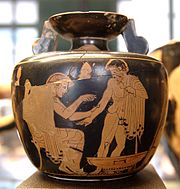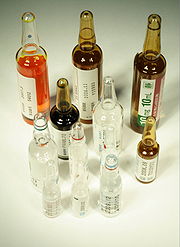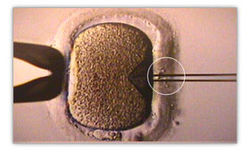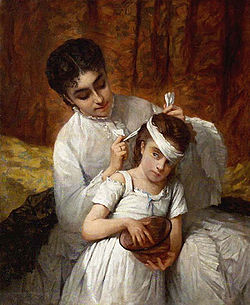
Medicine
Did you know...
The articles in this Schools selection have been arranged by curriculum topic thanks to SOS Children volunteers. See http://www.soschildren.org/sponsor-a-child to find out about child sponsorship.

Medicine encompasses a range of practices which aim to maintain and restore human health through the prevention and treatment of illness. Contemporary medicine relies upon health science, biomedical research, and medical technology to diagnose and treat injury and disease, typically through medication, surgery, or some other form of therapy. It has traditionally been regarded as both an art and a science: the term is derived from the Latin ars medicina meaning the art of healing. Although medical technology and clinical knowledge are a major part of contemporary medicine, successful face-to-face relief of actual suffering requires the intangible application of human feeling and compassion, which is referred to in English as " bedside manner."
History
Prehistoric medicine incorporated plants ( herbalism), animal parts and minerals. In many cases these materials were used ritually as magical substances by priests, shamans, or medicine men. Well-known spiritual systems include animism (the notion of inanimate objects having spirits), spiritualism (an appeal to gods or communion with ancestor spirits); shamanism (the vesting of an individual with mystic powers); and divination (magically obtaining the truth). The field of medical anthropology studies the various prehistoric medical systems and their interaction with society.
Early records on medicine have been discovered from early Ayurvedic medicine in Southeast Asia, Egyptian medicine, traditional Chinese medicine, the Americas, and Greece. Early Grecian doctors Hippocrates and Galen laid a foundation for later developments in a rational approach to medicine, and Hippocrates is known as the father of medicine. After the fall of Rome and the onset of the Dark Ages, Islamic scholars made major medical breakthroughs, supported by the translation of Hippocrates' and Galen's works into Arabic. Notable Islamic medical pioneers include polymath Avicenna, who is also called the father of medicine, Abulcasis, the father of surgery, Avenzoar, the father of experimental surgery, Ibn al-Nafis, the father of circulatory physiology, and Averroes. [Muhammad ibn Zakarīya Rāzi|Rhazes]], who is called the father of pediatrics, first disproved the Grecian theory of humorism, which nevertheless remained influential in Western medieval medicine. While major developments in medicine were occurring in the Islamic world during the medieval period, the Western world remained dependent upon the Greco-Roman theory of humorism, which led to questionable treatments such as bloodletting. Islamic medicine and medieval medicine collided during the crusades, with Islamic doctors receiving mixed impressions. As the medieval ages ended, important early figures in medicine emerged in Europe, including Gabriele Falloppio and William Harvey.
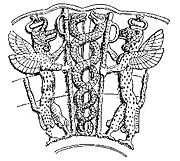
The focal points of development of clinical medicine shifted to the United Kingdom and the USA by the early 1900s (Canadian-born) Possibly the major shift in medical thinking was the gradual rejection, especially during the Black Death in the 14th and 15th centuries, of what may be called the 'traditional authority' approach to science and medicine. This was the notion that because some prominent person in the past said something must be so, then that was the way it was, and anything one observed to the contrary was an anomaly (which was paralleled by a similar shift in European society in general - see Copernicus's rejection of Ptolemy's theories on astronomy). Physicians like Ibn al-Nafis and Vesalius led the way in improving upon or indeed rejecting the theories of great authorities from the past (such as Hippocrates, Galen and Avicenna), many of whose theories were in time discredited. Such new attitudes were made possible in Europe by the weakening of the Roman Catholic church's power in society, especially in the Republic of Venice.
The modern scientific [biomedical research]] (where results are testable and reproducible) began to replace early Western traditions of medicine, based on herbalism, the Greek " four humours" and other premodern theories. The modern era began with Robert Koch's discoveries around 1880 of the transmission of disease by bacteria, and then the discovery of antibiotics shortly thereafter around 1900. The post-18th century modernity period brought more groundbreaking researchers from Europe. From Germany and Austrian doctors such as Rudolf Virchow, Wilhelm Conrad Röntgen, Karl Landsteiner, and Otto Loewi) made contributions. In the United Kingdom Alexander Fleming, Joseph Lister, Francis Crick, and Florence Nightingale are considered important. From New Zealand and Australia came Maurice Wilkins, Howard Floery, and Frank Macfarlane Burnet). In the United States William Williams Keen, Harvey Cushing, William Coley, James D. Watson, Italy ( Salvador Luria), Switzerland ( Alexandre Yersin), Japan ( Kitasato Shibasaburo), and France ( Jean-Martin Charcot, Claude Bernard, Paul Broca and others did significant work. Russian ( Nikolai Korotkov also did significant work, as did Sir William Osler and Harvey Cushing.
As science and technology developed, medicine became more reliant upon medications. Pharmacology developed from herbalism and many drugs are still derived from plants (atropine, ephedrine, warfarin, aspirin, digoxin, vinca alkaloids, taxol, hyoscine, etc). The first of these was arsphenamine / Salvarsan discovered by Paul Ehrlich in 1908 after he observed that bacteria took up toxic dyes that human cells did not. Vaccines were discovered by Edward Jenner and Louis Pasteur. The first major class of antibiotics was the sulfa drugs, derived by French chemists originally from azo dyes. This has become increasingly sophisticated; modern biotechnology allows drugs targeted towards specific physiological processes to be developed, sometimes designed for compatibility with the body to reduce side-effects. Genomics and knowledge of human genetics is having some influence on medicine, as the causative genes of most monogenic genetic disorders have now been identified, and the development of techniques in molecular biology and genetics are influencing medical technology, practice and decision-making.
Evidence-based medicine is a contemporary movement to establish the most effective algorithms of practice (ways of doing things) through the use of systematic reviews and meta-analysis. The movement is facilitated by the modern global information science, which allows all evidence to be collected and analyzed according to standard protocols which are then disseminated to healthcare providers. One problem with this 'best practice' approach is that it could be seen to stifle novel approaches to treatment. The Cochrane Collaboration leads this movement. A 2001 review of 160 Cochrane systematic reviews revealed that, according to two readers, 21.3% of the reviews concluded insufficient evidence, 20% concluded evidence of no effect, and 22.5% concluded positive effect.
Practice
The practice of medicine combines both science as the evidence base and art in the application of this medical knowledge in combination with intuition and clinical judgment to determine the treatment plan for each patient.
Central to medicine is the patient- physician relationship established when a person with a health concern seeks a physician's help; the 'medical encounter'. Other health professionals similarly establish a relationship with a patient and may perform various interventions, e.g. nurses, radiographers and therapists.
As part of the medical encounter, the healthcare provider needs to:
- develop a relationship with the patient
- gather data ( medical history, systems inquiry, and physical examination, combined with laboratory or imaging studies (investigations))
- analyze and synthesize that data (assessment and/or differential diagnoses), and then:
- develop a treatment plan (further testing, therapy, watchful observation, referral and follow-up)
- treat the patient accordingly
- assess the progress of treatment and alter the plan as necessary (management).
The medical encounter is documented in a medical record, which is a legal document in many jurisdictions.
Delivery systems
Medicine is practiced within the medical system, which is a legal, credentialing and financing framework, established by a particular culture or government. The characteristics of a health care system have significant effect on the way medical care is delivered.
Most industrialized countries and many developing countries deliver health care though a system of universal health care which guarantees care for all through a system of compulsory private or co-operative health insurance funds or via government-backed social insurance. This insurance (in effect, a form of taxation) ensures that the entire population has access to medical care on the basis of need rather than ability to pay. The delivery systems may be provided by private medical practices or by state-owned hospitals and clinics, or by charities.
Most tribal societies but also some communist countries (e.g. China) and at least one industrialized capitalist country (the United States) provide no guarantee of health care for the population as a whole. In such societies, health care is available to those that can afford to pay for it or have self insured it (either directly or as part of an employment contract) or who may be covered by care financed by the government or tribe directly.
Transparency of information is another factor defining a delivery system. Access to information on conditions, treatments, quality and pricing greatly affects the choice by patients / consumers and therefore the incentives of medical professionals. While the US health care system has come under fire for lack of openness , new legislation may encourage greater openness. There is a perceived tension between the need for transparency on the one hand and such issues as patient confidentiality and the possible exploitation of information for commercial gain on the other.
Delivery
Medical care delivery is classified into primary, secondary and tertiary care.
Primary care medical services are provided by physicians or other health professionals who have first contact with a patient seeking medical treatment or care. These occur in physician offices, clinics, nursing homes, schools, home visits and other places close to patients. About 90% of medical visits can be treated by the primary care provider. These include treatment of acute and chronic illnesses, preventive care and health education for all ages and both sexes.
Secondary care medical services are provided by medical specialists in their offices or clinics or at local community hospitals for a patient referred by a primary care provider who first diagnosed or treated the patient. Referrals are made for those patients who required the expertise or procedures performed by specialists. These include both ambulatory care and inpatient services, emergency rooms, intensive care medicine, surgery services, physical therapy, labor and delivery, endoscopy units, diagnostic laboratory and medical imaging services, hospice centers, etc. Some primary care providers may also take care of hospitalized patients and deliver babies in a secondary care setting.
Tertiary care medical services are provided by specialist hospitals or regional centers equipped with diagnostic and treatment facilities not generally available at local hospitals. These include trauma centers, burn treatment centers, advanced neonatology unit services, organ transplants, high-risk pregnancy, radiation oncology, etc.
Modern medical care also depends on information - still delivered in many health care settings on paper records, but increasingly nowadays by electronic means.
Patient-physician-relationship
This kind of relationship and interaction is a central process in the practice of medicine. There are many perspectives from which to understand and describe it.
An idealized physician's perspective, such as is taught in medical school, sees the core aspects of the process as the physician learning the patient's symptoms, concerns and values; in response the physician examines the patient, interprets the symptoms, and formulates a diagnosis to explain the symptoms and their cause to the patient and to propose a treatment. The job of a physician is similar to a human biologist: that is, to know the human frame and situation in terms of normality. Once the physician knows what is normal and can measure the patient against those norms, he or she can then determine the particular departure from the normal and the degree of departure. This is called the diagnosis.
The four great cornerstones of diagnostic medicine are anatomy (structure: what is there), physiology (how the structure/s work), pathology (what goes wrong with the anatomy and physiology) and psychology (mind and behaviour). In addition, the physician should consider the patient in their 'well' context rather than simply as a walking medical condition. This means the socio-political context of the patient (family, work, stress, beliefs) should be assessed as it often offers vital clues to the patient's condition and further management.
A patient typically presents a set of complaints (the symptoms) to the physician, who then obtains further information about the patient's symptoms, previous state of health, living conditions, and so forth. The physician then makes a review of systems (ROS) or systems inquiry, which is a set of ordered questions about each major body system in order: general (such as weight loss), endocrine, cardio-respiratory, etc. Next comes the actual physical examination and often laboratory tests; the findings are recorded, leading to a list of possible diagnoses. These will be investigated in order of probability.
The next task is to enlist the patient's agreement to a management plan, which will include treatment as well as plans for follow-up. Importantly, during this process the healthcare provider educates the patient about the causes, progression, outcomes, and possible treatments of his ailments, as well as often providing advice for maintaining health. This teaching relationship is the basis of calling the physician doctor, which originally meant "teacher" in Latin. The patient- physician relationship is additionally complicated by the patient's suffering (patient derives from the Latin patior, "suffer") and limited ability to relieve it on his/her own. The physician's expertise comes from his knowledge of what is healthy and normal contrasted with knowledge and experience of other people who have suffered similar symptoms (unhealthy and abnormal), and the proven ability to relieve it with medicines (pharmacology) or other therapies about which the patient may initially have little knowledge.
The physician-patient relationship can be analyzed from the perspective of ethical concerns, in terms of how well the goals of non-maleficence, beneficence, autonomy, and justice are achieved. Many other values and ethical issues can be added to these. In different societies, periods, and cultures, different values may be assigned different priorities. For example, in the last 30 years medical care in the Western World has increasingly emphasized patient autonomy in decision making.
The relationship and process can also be analyzed in terms of social power relationships (e.g., by Michel Foucault), or economic transactions. Physicians have been accorded gradually higher status and respect over the last century, and they have been entrusted with control of access to prescription medicines as a public health measure. This represents a concentration of power and carries both advantages and disadvantages to particular kinds of patients with particular kinds of conditions. A further twist has occurred in the last 25 years as costs of medical care have risen, and a third party (an insurance company or government agency) now often insists upon a share of decision-making power for a variety of reasons, reducing freedom of choice of healthcare providers and patients in many ways.
The quality of the patient- physician relationship is important to both parties. The better the relationship in terms of mutual respect, knowledge, trust, shared values and perspectives about disease and life, and time available, the better will be the amount and quality of information about the patient's disease transferred in both directions, enhancing accuracy of diagnosis and increasing the patient's knowledge about the disease. Where such a relationship is poor the physician's ability to make a full assessment is compromised and the patient is more likely to distrust the diagnosis and proposed treatment. In these circumstances and also in cases where there is genuine divergence of medical opinions, a second opinion from another physician may be sought or the patient may choose to go to another doctor.
In some settings, e.g. the hospital ward, the patient-physician relationship is much more complex, and many other people are involved when somebody is ill: relatives, neighbors, rescue specialists, nurses, technical personnel, social workers and others.
Clinical skills
A complete medical evaluation includes a medical history, a systems enquiry, a physical examination, appropriate laboratory or imaging studies, analysis of data and medical decision making to obtain diagnoses, and a treatment plan.
The components of the medical history are:
- Chief complaint (CC): the reason for the current medical visit. These are the 'symptoms.' They are in the patient's own words and are recorded along with the duration of each one. Also called 'presenting complaint.'
- History of present illness / complaint (HPI): the chronological order of events of symptoms and further clarification of each symptom.
- Current activity: occupation, hobbies, what the patient actually does.
- Medications (DHx): what drugs the patient takes including prescribed, over-the-counter, and home remedies, as well as alternative and herbal medicines/herbal remedies. Allergies are also recorded.
- Past medical history (PMH/PMHx): concurrent medical problems, past hospitalizations and operations, injuries, past infectious diseases and/or vaccinations, history of known allergies.
- Social history (SH): birthplace, residences, marital history, social and economic status, habits (including diet, medications, tobacco, alcohol).
- Family history (FH): listing of diseases in the family that may impact the patient. A family tree is sometimes used.
- Review of systems (ROS) or systems inquiry: a set of additional questions to ask which may be missed on HPI: a general enquiry (have you noticed any weight loss, change in sleep quality, fevers, lumps and bumps? etc), followed by questions on the body's main organ systems (heart, lungs, digestive tract, urinary tract, etc).
The physical examination is the examination of the patient looking for signs of disease ('Symptoms' are what the patient volunteers, 'Signs' are what the healthcare provider detects by examination). The healthcare provider uses the senses of sight, hearing, touch, and sometimes smell (taste has been made redundant by the availability of modern lab tests). Four chief methods are used: inspection, palpation (feel), percussion (tap to determine resonance characteristics), and auscultation (listen); smelling may be useful (e.g. infection, uremia, diabetic ketoacidosis). The clinical examination involves study of:
- Vital signs including height, weight, body temperature, blood pressure, pulse, respiration rate, hemoglobin oxygen saturation
- General appearance of the patient and specific indicators of disease (nutritional status, presence of jaundice, pallor or clubbing)
- Skin
- Head, eye, ear, nose, and throat (HEENT)
- Cardiovascular (heart and blood vessels)
- Respiratory (large airways and lungs)
- Abdomen and rectum
- Genitalia (and pregnancy if the patient is or could be pregnant)
- Musculoskeletal (spine and extremities)
- Neurological (consciousness, awareness, brain, cranial nerves, spinal cord and peripheral nerves)
- Psychiatric (orientation, mental state, evidence of abnormal perception or thought)
Laboratory and imaging studies results may be obtained, if necessary.
The medical decision-making (MDM) process involves analysis and synthesis of all the above data to come up with a list of possible diagnoses (the differential diagnoses), along with an idea of what needs to be done to obtain a definitive diagnosis that would explain the patient's problem.
The treatment plan may include ordering additional laboratory tests and studies, starting therapy, referral to a specialist, or watchful observation. Follow-up may be advised.
This process is used by primary care providers as well as specialists. It may take only a few minutes if the problem is simple and straightforward. On the other hand, it may take weeks in a patient who has been hospitalized with bizarre symptoms or multi-system problems, with involvement by several specialists.
On subsequent visits, the process may be repeated in an abbreviated manner to obtain any new history, symptoms, physical findings, and lab or imaging results or specialist consultations.
Branches
Working together as an interdisciplinary team, many highly-trained health professionals besides medical practitioners are involved in the delivery of modern health care. Examples include: nurses, emergency medical technicians and paramedics, laboratory scientists, (pharmacy, pharmacists), (physiotherapy,physiotherapists), respiratory therapists, speech therapists, occupational therapists, radiographers, dietitians and bioengineers.
The scope and sciences underpinning human medicine overlap many other fields. Dentistry and psychology, while separate disciplines from medicine, are considered medical fields.
A patient admitted to hospital is usually under the care of a specific team based on their main presenting problem, e.g. the Cardiology team, who then may interact with other specialties, e.g. surgical, radiology, to help diagnose or treat the main problem or any subsequent complications / developments.
Physicians have many specializations and subspecializations into certain branches of medicine, which are listed below. There are variations from country to country regarding which specialties certain subspecialties are in.
The main branches of medicine used in Wikipedia are:
- Basic sciences of medicine; this is what every physician is educated in, and some return to in biomedical research.
- Medical specialties
- interdisciplinary fields, where different medical specialties are mixed to function in certain occasions.
Basic sciences
- Anatomy is the study of the physical structure of organisms. In contrast to macroscopic or gross anatomy, cytology and histology are concerned with microscopic structures.
- Biochemistry is the study of the chemistry taking place in living organisms, especially the structure and function of their chemical components.
- Biostatistics is the application of statistics to biological fields in the broadest sense. A knowledge of biostatistics is essential in the planning, evaluation, and interpretation of medical research. It is also fundamental to epidemiology and evidence-based medicine.
- Cytology is the microscopic study of individual cells.
- Embryology is the study of the early development of organisms.
- Epidemiology is the study of the demographics of disease processes, and includes, but is not limited to, the study of epidemics.
- Genetics is the study of genes, and their role in biological inheritance.
- Histology is the study of the structures of biological tissues by light microscopy, electron microscopy and immunohistochemistry.
- Immunology is the study of the immune system, which includes the innate and adaptive immune system in humans, for example.
- Medical physics is the study of the applications of physics principles in medicine.
- Microbiology is the study of microorganisms, including protozoa, bacteria, fungi, and viruses.
- Neuroscience includes those disciplines of science that are related to the study of the nervous system. A main focus of neuroscience is the biology and physiology of the human brain and spinal cord.
- Nutrition is the study of the relationship of food and drink to health and disease, especially in determining an optimal diet. Medical nutrition therapy is done by dietitians and is prescribed for diabetes, cardiovascular diseases, weight and eating disorders, allergies, malnutrition, and neoplastic diseases.
- Pathology as a science is the study of disease—the causes, course, progression and resolution thereof.
- Pharmacology is the study of drugs and their actions.
- Physiology is the study of the normal functioning of the body and the underlying regulatory mechanisms.
- Toxicology is the study of hazardous effects of drugs and poisons.
Specialties
In the broadest meaning of "medicine", there are many different specialties. However, within medical circles, there are two broad categories: "Medicine" and "Surgery." "Medicine" refers to the practice of non-operative medicine, and most subspecialties in this area require preliminary training in "Internal Medicine". "Surgery" refers to the practice of operative medicine, and most subspecialties in this area require preliminary training in "General Surgery." There are some specialties of medicine that do not fit into either of these categories, such as radiology, pathology, or anesthesia, and those are also discussed further below.
Surgery
Surgical specialties employ operative treatment. In addition, surgeons must decide when an operation is necessary, and also treat many non-surgical issues, particularly in the surgical intensive care unit (SICU), where a variety of critical issues arise. Surgery has many subspecialties, e.g. general surgery, trauma surgery, cardiovascular surgery, neurosurgery, maxillofacial surgery, orthopedic surgery, otolaryngology, plastic surgery, oncologic surgery, vascular surgery, and pediatric surgery. In some centers, anesthesiology is part of the division of surgery (for logistical and planning purposes), although it is not a surgical discipline.
Surgical training in the U.S. requires a minimum of five years of residency after medical school. Sub-specialties of surgery often require seven or more years. In addition, fellowships can last an additional one to three years. Because post-residency fellowships can be competitive, many trainees devote two additional years to research. Thus in some cases surgical training will not finish until more than a decade after medical school. Furthermore, surgical training can be very difficult and time consuming. A surgical resident's average work week is approximately 75 hours. Some subspecialties of surgery, such as neurosurgery, require even longer hours, and utilize an extension to the 80 hour regulated work week, allowing up to 88 hours per week. Many surgical programs still exceed this work hour limit. Attempts to limit the amount of hours worked has been difficult because of the large volume of patients who require surgical care, the limited amount of resources (including a shortage of people willing to enter into surgery as a career), the need to perform long operations and still provide care to all pre- and post-operative patients, and the need to provide constant coverage in the OR, ICU, and ER.
Medicine
- Internal medicine is concerned with systemic diseases of adults, i.e. those diseases that affect the body as a whole (restrictive, current meaning), or with all adult non-operative somatic medicine (traditional, inclusive meaning), thus excluding pediatrics, surgery, gynecology and obstetrics, and psychiatry. Practitioners of such specialties are referred to as physicians. There are several subdisciplines of internal medicine:
-
- Cardiology
- Critical care medicine
- Endocrinology
- Gastroenterology
- Hematology
- Hepatology
- Infectious diseases
- Nephrology
- Oncology
- Proctology
- Pulmonology
- Rheumatology
- Sleep medicine in the USA
- Neurology
- Geriatrics
Generally, Pediatrics and Family Practice are also considered to fall under the category of "Medicine".
Medical training, as opposed to surgical training, requires three years of residency training after medical school. This can then be followed by a one to two year fellowship in the subspecialties listed above. In general, resident work hours in medicine are less than those in surgery, averaging about 60 hours per week in the USA.
Diagnostic specialties
- Clinical laboratory sciences are the clinical diagnostic services which apply laboratory techniques to diagnosis and management of patients. In the United States these services are supervised by a pathologist. The personnel that work in these medical laboratory departments are technically trained staff who do not hold medical degrees, but who usually hold an undergraduate medical technology degree, who actually perform the tests, assays, and procedures needed for providing the specific services. Subspecialties include Transfusion medicine, Cellular pathology, Clinical chemistry, Hematology, Clinical microbiology and Clinical immunology.
- Pathology as a medical specialty is the branch of medicine that deals with the study of diseases and the morphologic, physiologic changes produced by them. As a diagnostic specialty, pathology can be considered the basis of modern scientific medical knowledge and plays a large role in evidence-based medicine. Many modern molecular tests such as flow cytometry, polymerase chain reaction (PCR), immunohistochemistry, cytogenetics, gene rearrangements studies and fluorescent in situ hybridization (FISH) fall within the territory of pathology.
- Radiology is concerned with imaging of the human body, e.g. by x-rays, x-ray computed tomography, ultrasonography, and nuclear magnetic resonance tomography.
- Clinical neurophysiology is concerned with testing the physiology or function of the central and peripheral aspects of the nervous system. These kinds of tests can be divided into recordings of: (1) spontaneous or continuously running electrical activity, or (2) stimulus evoked responses. Subspecialties include Electroencephalography, Electromyography, Evoked potential, Nerve conduction study and Polysomnography. Sometimes these tests are performed by techs without a medical degree, but the interpretation of these tests is done by a medical professional.
Other
Following are some selected fields of medical specialties that don't directly fit into any of the above mentioned groups.
- Ophthalmology exclusively concerned with the eye and ocular adnexa. Combines conservative and surgical therapy, and has its own College.
- Dermatology is concerned with the skin and its diseases. In the UK, dermatology is a subspecialty of general medicine.
- Emergency medicine is concerned with the diagnosis and treatment of acute or life-threatening conditions, including trauma, surgical, medical, pediatric, and psychiatric emergencies.
- Obstetrics and gynecology (often abbreviated as OB/GYN) are concerned respectively with childbirth and the female reproductive and associated organs. Reproductive medicine and fertility medicine are generally practiced by gynecological specialists.
- Palliative care is a relatively modern branch of clinical medicine that deals with pain and symptom relief and emotional support in patients with terminal illnesses including cancer and heart failure.
- Pediatrics (AE) or paediatrics (BE) is devoted to the care of infants, children, and adolescents. Like internal medicine, there are many pediatric subspecialties for specific age ranges, organ systems, disease classes, and sites of care delivery.
- Physical medicine and rehabilitation (or physiatry) is concerned with functional improvement after injury, illness, or congenital disorders.
- Psychiatry is the branch of medicine concerned with the bio-psycho-social study of the etiology, diagnosis, treatment and prevention of cognitive, perceptual, emotional and behavioural disorders. Related non-medical fields include psychotherapy and clinical psychology.
Interdisciplinary fields
Interdisciplinary sub-specialties of medicine are:
- General practice, family practice, family medicine or primary care is, in many countries, the first port-of-call for patients with non-emergency medical problems.
- Many other health science fields, e.g. dietetics
- Bioethics is a field of study which concerns the relationship between biology, science, medicine and ethics, philosophy and theology.
- Biomedical Engineering is a field dealing with the application of engineering principles to medical practice.
- Clinical pharmacology is concerned with how systems of therapeutics interact with patients.
- Conservation medicine studies the relationship between human and animal health, and environmental conditions. Also known as ecological medicine, environmental medicine, or medical geology.
- Disaster medicine deals with medical aspects of emergency preparedness, disaster mitigation and management.
- Diving medicine (or hyperbaric medicine) is the prevention and treatment of diving-related problems.
- Evolutionary medicine is a perspective on medicine derived through applying evolutionary theory.
- Forensic medicine deals with medical questions in legal context, such as determination of the time and cause of death.
- Gender-based medicine studies the biological and physiological differences between the human sexes and how that affects differences in disease.
- Hospital medicine is the general medical care of hospitalized patients. Physicians whose primary professional focus is hospital medicine are called hospitalists in the USA.
- Medical humanities includes the humanities (literature, philosophy, ethics, history and religion), social science (anthropology, cultural studies, psychology, sociology), and the arts (literature, theatre, film, and visual arts) and their application to medical education and practice.
- Medical informatics, medical computer science, medical information and eHealth are relatively recent fields that deal with the application of computers and information technology to medicine.
- Nosology is the classification of diseases for various purposes.
- Preventive medicine is the branch of medicine concerned with preventing disease.
- Community health or public health is an aspect of health services concerned with threats to the overall health of a community based on population health analysis.
- Occupational medicine's principal role is the provision of health advice to organizations and individuals to ensure that the highest standards of health and safety at work can be achieved and maintained.
- Aerospace medicine deals with medical problems related to flying and space travel.
- Osteopathic medicine, a branch of the U.S. medical profession.
- Pharmacogenomics is a form of individualized medicine.
- Sports medicine deals with the treatment and preventive care of athletes, amateur and professional. The team includes specialty physicians and surgeons, athletic trainers, physical therapists, coaches, other personnel, and, of course, the athlete.
- Therapeutics is the field, more commonly referenced in earlier periods of history, of the various remedies that can be used to treat disease and promote health .
- Travel medicine or emporiatrics deals with health problems of international travelers or travelers across highly different environments.
- Professions complementing physicians
- Nursing specialties: specialties performed by Nurses.
- Mid-level practitioners: performance of medical sciences by other certified people than physicians or nurses; Nurse practitioners, midwives and physician assistants, treat patients and prescribe medication in many jurisdictions.
- Allied health professions: a diverse set of clinical healthcare professions distinct from medicine and nursing.
- Urgent care focuses on delivery of unscheduled, walk-in care outside of the hospital emergency department for injuries and illnesses that are not severe enough to require care in an emergency department. In some jurisdictions this function is combined with the emergency room.
- Veterinary medicine; veterinarians apply similar techniques as physicians to the care of animals.
Education
Medical education is education connected to the practice of being a medical practitioner, either the initial training to become a physician or further training thereafter.
Medical education and training varies considerably across the world, however typically involves entry level education at a university medical school, followed by a period of supervised practice ( internship and/or residency) and possibly postgraduate vocational training. Continuing medical education is a requirement of many regulatory authorities.
Various teaching methodologies have been utilized in medical education, which is an active area of educational research.
Legal restrictions
In most countries, it is a legal requirement for a medical doctor to be licensed or registered. In general, this entails a medical degree from a university and accreditation by a medical board or an equivalent national organization, which may ask the applicant to pass exams. This restricts the considerable legal authority of the medical profession to physicians that are trained and qualified by national standards. It is also intended as an assurance to patients and as a safeguard against charlatans that practice inadequate medicine for personal gain. While the laws generally require medical doctors to be trained in "evidence based", Western, or Hippocratic Medicine, they are not intended to discourage different paradigms of health.
Criticism
Criticism of medicine has a long history. In the Middle Ages, some people did not consider it a profession suitable for Christians, as disease was often considered God-sent. God was considered to be the "divine physician" who sent illness or healing depending on his will. However, many monastic orders, particularly the Benedictines, considered the care of the sick as their chief work of mercy. Barber-surgeons generally had a bad reputation that was not to improve until the development of academic surgery as a specialty of medicine, rather than an accessory field.
Through the course of the twentieth century, healthcare providers focused increasingly on the technology that was enabling them to make dramatic improvements in patients' health. The ensuing development of a more mechanistic, detached practice, with the perception of an attendant loss of patient-focused care, known as the medical model of health, led to further criticisms. This issue started to reach collective professional consciousness in the 1970s and the profession had begun to respond by the 1980s and 1990s.
The anti-authoritarian Catholic social theorist Ivan Illich subjected contemporary western medicine to detailed attack in his Medical Nemesis, first published in 1975. He argued that the medicalization in recent decades of so many of life's vicissitudes — birth and death, for example — frequently caused more harm than good, rendering many in effect lifelong patients. Marshalling a body of statistics that indicated what he considered the shocking extent in advanced industrial society of post-operative side-effects and drug-induced illness , Illich was the first to introduce to a wider public the notion of iatrogenesis Other critics have since voiced similar views but none so trenchantly, perhaps, as Illich.
The inability of modern medicine to properly address some common complaints continues to prompt many people to seek support from alternative medicine. Although most alternative approaches lack scientific validation, some may be effective in individual cases. Some physicians combine alternative medicine with orthodox approaches.
Medical errors and overmedication are also the focus of complaints and negative coverage. Practitioners of human factors engineering believe that there is much that medicine may usefully gain by emulating concepts in aviation safety, where it was long ago realized that it is dangerous to place too much responsibility on one "superhuman" individual and expect him or her not to make errors. Reporting systems and checking mechanisms are becoming more common in identifying sources of error and improving practice.
